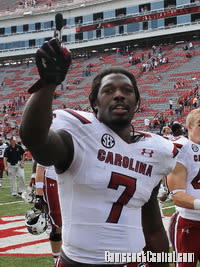NFL combine invites: Where they come from

Click Here to view this video.
Advertisement
The NFL scouting combine recently sent out its invitations, beckoning 335 of college football's best players to Indianapolis for rounds of testing and interviews Feb. 22-25. Not all who attend will fully participate, as many of the top prospects elect to showcase their abilities in a controlled environment such as a pro day than on the track at Lucas Oil Stadium (for example, both Derek Carr and AJ McCarron have said they are unsure if they'll take part in passing drills).
But with the chance to meet executives and talent evaluators from a host of NFL teams, very few turn down a combine invite, making the event the largest gathering of college talent all year long. This makes the combine a great place to gauge the talent level of each college conference. It's not a foolproof indicator - some conferences have stockpiled young talent or have a number of underrated players or prospects coming off of injuries. But for the most part, the combine gives us a taste on which conferences are hoarding the most talent.
The SEC, which had won the previous seven national titles before Florida State took down Auburn in January, would seem the obvious favorite to send the most players to Indianapolis. The conference is flush with talent and had 12 players selected in the first round of last year's draft. But the Pac-12 is working hard to catch up while the Big Ten, Big 12 and ACC are fighting for respectability as well.
Here's the breakdown on what conferences combine invitees hail from and what position they play:
http-equiv="content-type">

Not surprisingly, the SEC takes the top spot with a whopping 70 prospects, leading the major conferences in invites for quarterbacks, wide receivers and offensive and defensive linemen. The list includes a number of potential top ten picks, including South Carolina defensive end Jadeveon Clowney, Texas A&M quarterback Johnny Manziel and Auburn offensive lineman Greg Robinson. Alabama (12) and LSU (11) received more invites than any other school (conference champion and national runner-up Auburn had five).
Known for its strong collection of defenses, the SEC is sending 29 defensive players to the combine. But the Pac-12 and ACC aren't far behind and will send 25 and 24 defensive prospects, respectively. The SEC also leads the major conferences with 38 invites for offensive players, followed by the ACC with 24 and the Pac-12 with 22.
The Big Ten and Big 12 didn't make much noise, combing for 62 invites, fewer than the SEC alone. But those leagues make up in quality what they lack in quantity - five of ESPN analyst Mel Kiper Jr.'s top 25 draft prospects come from those conferences, including Michigan tackle Taylor Lewan and Oklahoma State cornerback Justin Gilbert.
It was strange to see two conferences dominate the quarterback position so much - the SEC (Manziel, McCarron, Zach Mettenberger, Aaron Murray and Connor Shaw) and the ACC (Tajh Boyd, Stephen Morris, Logan Thomas, Tom Savage and Bryn Renner) each put five quarterbacks in the combine, while the other three power conferences didn't supply a single passer. Meanwhile, smaller prospects such as Dustin Vaughan (West Texas A&M), Jeff Mathews (Cornell) and Jimmy Garoppolo (Eastern Illinois) all received invites.
Now let's turn the attention on Rivals.com to see how well it ranked the prospects in the field. It goes without saying that the numbers figured to be skewed toward the middle at each position. There are simply a greater number of three-stars than four and five-star prospects each year -- some positions may not even have a five-star recruit in a given season. In the Rivals class of 2010, for example, there were only 26 five-star athletes. Eight were invited to last year's combine and eight were invited to this year's combine.
Here's how it breaks down:
http-equiv="content-type">

Rivals did a pretty solid job in scouting this combine class. Several positions were led by four-stars, while three-stars make up the greatest percentage of the invites. There will be 82 prospects at the combine that Rivals ranked as two-stars or didn't rate at all. But when judging thousands of high school prospects across the country, there are going to be a handful of late bloomers, as well as a few who slip through the cracks.
Running backs in particular tended to be more highly-ranked, as 17 of the 36 invites at the position were extended to former four or five-star prospects, including Baylor's Lache Seastrunk (2010 five-star) and Alabama State's Isaiah Crowell (2011 five-star).
No five-star quarterbacks got an invite simply because there weren't many to choose from - the only five-star prospects at the position in the 2009-11 classes were Matt Barkley and Garrett Gilbert. The former is already a member of the Philadelphia Eagles, while the latter didn't show enough at SMU to warrant an invitation.
There were 82 prospects invited who were originally two-stars or weren't ranked, but the scouting of high school players is an imperfect science. Take, for example, a pair of invitees from Nebraska - Stanley Jean-Baptiste originally arrived at the school as a wide receiver before transforming into one of the league's top cornerbacks, while offensive lineman Spencer Long is a former walk-on who had to redshirt and add more than 60 pounds to develop into an All-American candidate.
It's important to keep in mind that recruiting is only half the battle. There are innumerable examples of coaches who brought in strong classes yet couldn't build a winner at their schools. As the above chart shows, player development is often what decides what kind of pro prospect a recruit is going to be.

Click Here to view this Link.
[rl]